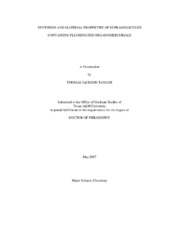| dc.description.abstract | This dissertation details the synthesis and analysis of novel supramolecular
species that feature simple fluorinated organomercurials, such as trimeric perfluoroortho-
phenylene mercury ([o-C6F4Hg]3). These organomercurials can complex a variety
of unsaturated substrates including arenes and alkynes. The major emphasis was on
developing molecular architectures that are held together in part by secondary Hg-Calkyne
interactions.
Diphenylpolyynes, hydrocarbons featuring extended regions of unsaturation,
were found to complex with [o-C6F4Hg]3 in a series of adducts. While the internal
structures of the hydrocarbons themselves were found to be basically unaltered, within
the crystals the polyynes were physically separated from one another by intervening
molecules of [o-C6F4Hg]3, preventing them from cross-linking. This leads to a
substantial stabilizing effect, for example [o-C6F4Hg]3 and Ph(CC)4Ph form a 2:1
adduct that is stable at temperatures up to 120 ºC above the pure hydrocarbon.
Adducts of [o-C6F4Hg]3 and molecules containing a 1,3,5-triethynyl benzene
core display a variety of novel properties. 1,3,5-tris(trimethylsilylethynyl) benzene
forms binary supramolecular stacks with [o-C6F4Hg]3. The structure also displays large
cylindrical 1-dimensional cavities. These cavities are lined with non-polar groups, have
an internal diameter of 6.2 Å, and remain stable in the absence of guests. The compound
readily interacts with and reversibly adsorbs simple alkanes.
1,3,5-tris(phenylethynyl) benzene forms similar stacks with [o-C6F4Hg]3, albeit
without the cavities. Upon irradiation with visible and ultraviolet light, this adduct emits a long-lived emission that was hitherto unreported. From computer calculations and
lifetime measurements, it appears this radiation is the phosphorescence of the pure
hydrocarbon.
Intensive structural studies have also been performed on adducts containing
polyaromatic compounds, including phenanthrene, and the organomercurials [o-
C6F4Hg]3, pentafluorophenyl mercury chloride and bromide. These experiments were
performed to determine if Lewis acid-p complexes could be made with monofunctional
mercury compounds. Polyaromatic hydrocarbons, such as phenanthrene and
diphenylacetylene, were used as the substrates for these investigations. While all the
mercurials formed adducts with the substrates, the photophysical measurements were not
uniform and indicate that [o-C6F4Hg]3 has a stronger heavy-atom effect because of the
cooperativity of the three mercury atoms. | en |


